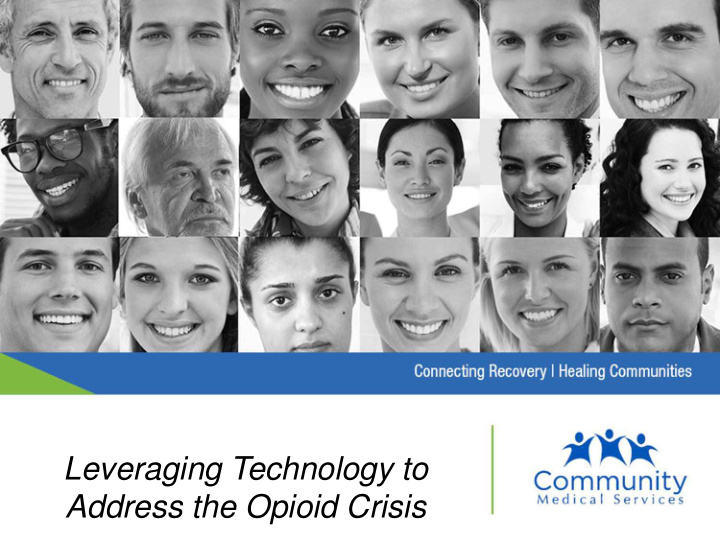



Leveraging Technology to Address the Opioid Crisis
Presentation Goals Define the problem Frame the Discussion Discuss OTP Operations HIE Tie-In Centralized State Registry Discuss our experience with internal Data Management Discuss the role of Telehealth in MAT Delivery
How did w e get here? Prescription drug overdoses is now the leading cause of accidental death in the US. 1 person dies every 19 minutes due to an overdose of an opioid. The US consumes 80% of the world’s global opiate supply but is only 5% of the world’s population. Overdose deaths have quadrupled since 2000. Opiates prescribed for pain have quadrupled since 1999 however Americans have not reported any increase in the amount of pain There are 2.4 million untreated opioid dependent individuals in the US. Only 20% of them are receiving MAT. 91% of patients who overdose will receive another prescription for the same opiate that they overdosed on.
Fram ing the Discussion
Patient Outcom es/ Key Perform ance Indicators National average success rates for MAT range from 60%-90%, vs. 5%-10% for behavioral interventions alone After one year in treatment, crime rates among patients decreased -19% while jail time decreased -25% Time spent unemployed decreased 30% OTP services (e.g., medication management, counseling and treatment of co-occurring disorders) promote measurably positive treatment outcomes, as measured by Key Performance Indicators (or “KPIs”) Testing “Negative” For Illicit Opiates at Different Stages of Treatment 93% 2 or more years in treatment 88% 1 – 2 years in treatment 83% 6 –12 months in treatment 77% 1 –6 months in treatment 61% 90 days or less in treatment
Integration of MAT Providers
Integration of MAT Providers
Patient Outcom es/ Key Perform ance Indicators Old Method of Data Input Individual Clinic Dashboard
Patient Outcom es/ Key Perform ance Indicators Old Method of Data Visualization Individual Clinic Dashboard
Patient Outcom es/ Key Perform ance Indicators Server Architecture Tableau Cloud Backup SQL Server Database Database Database Data Warehouse (Database) Backup 2 Direct Link Clinic 1 Clinic 2 Clinic 3 Table 1a Table 1b Table 1c Table 2a Table 2b Table 2c Table 3a Table 3b Table 3c Backup 1 BDR 1 BDR 2 BDR 2
Patient Outcom es/ Key Perform ance Indicators The Company tracks and benchmarks performance metrics at the individual clinic and company level. Key metrics include: Productivity: Clinician time spent providing counseling services vs. performing case management activities Wait Times: Patient time spent waiting to receive dosing at clinic Clinic financial metrics: Hours per client per month, broken out by service component Individual Clinic Dashboard
Telehealth Telehealth can be used as a force multiplier to help address the shortage in healthcare workers. Telehealth does not diminish the quality of care being given, an oftentimes enhances it. 1. Research indicates that the majority of patients either prefer telemedicine to an in-person experience or think it is on par with in-person communications. 2. Study : 29 of 31 patients who were interviewed by telephone preferred telepsychiatry to waiting for a consultation, were willing to use the service again and would recommend telepsychiatry to a friend. 3. Studies have also shown that telemedicine can often times lead to higher diagnostic accuracy in medical settings compared to in-person examinations. 4. The quality of care in general is no different between telemedicine visits and in-person examinations. 1. https://www.ncbi.nlm.nih.gov/pubmed/19919189 2. http://jtt.sagepub.com/content/7/3/155.short 3. https://www.ncbi.nlm.nih.gov/pubmed/15682957 4. http://www.jpgmonline.com/article.asp?issn=0022-3859;year=2005;volume=51;issue=4;spage=294;epage=300;aulast=Whitten 5. http://acaai.org/news/telemedicine-effective-person-visits-children-asthma
Telehealth Telehealth can be used as a force multiplier to help address the shortage in healthcare workers Research indicates that the majority of patients either prefer telemedicine to an in-person experience or think it is on par with in-person communications. Study: 29 of 31 patients who were interviewed by telephone preferred telepsychiatry to waiting for a consultation, were willing to use the service again and would recommend telepsychiatry to a friend
Needs from the Federal and State Level 42 CFR Part 2 Changes Central OTP Registry for Arizona Federal Telemedicine Law Changes More Comprehensive Needs Assessment Centralized Data Repository
Recommend
More recommend